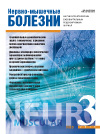Vol 4, No 3 (2014)
- Year: 2014
- Published: 19.09.2014
- Articles: 7
- URL: https://nmb.abvpress.ru/jour/issue/view/3
Full Issue
LECTURES AND REVIEWS
Acetyl-L-carnitine improves pain, nerve regeneration, and vibratory perception in patients with chronic diabetic neuropathy
Abstract
Objective — we evaluated frozen databases from two 52‑week randomized placebocontrolled clinical diabetic neuropathy trials testing two doses of acetyl-l-carnitine (alc): 500 and 1,000 mg / day t. i. d.
Research design and methods — intention-to-treat patients amounted to 1,257 or 93 % of enrolled patients. Efficacy end points were sural nerve morphometry, nerve conduction velocities, vibration perception thresholds, clinical symptom scores, and a visual analogue scale for most bothersome symptom, most notably pain. The two studies were evaluated separately and combined.
Results — data showed significant improvements in sural nerve fiber numbers and regenerating nerve fiber clusters. Nerve conduction velocities and amplitudes did not improve, whereas vibration perception improved in both studies. Pain as the most bothersome symptom showed significant improvement in one study and in the combined cohort taking 1,000 mg alc.
Conclusions — these studies demonstrate that alc treatment is efficacious in alleviating symptoms, particularly pain, and improves nerve fiber regeneration and vibration perception in patients with established diabetic neuropathy.
 6-12
6-12


Adequate managment of patients with dystrophinopathies (muscular dystrophy Duchenne/Becker): objective scales and additional diagnostic methods
Abstract
There are still no guidlines on managment of Duchenne/Becker myodystrophy in domestic medical practice. It leads to decrease of quality of life and, what is more important, lifespan of patients. In this article we have described our Western coleagues lаst decade experience, including consensus guidelines published in 2010 on mаnаgment of Duchenne myodystrophy, supplemented with our practicle experience. We have described standardized motor development scale and muscle tone score for patients with MDD/MDB, and algorithm of multidiscipline care with focus on prevention, diagnosis and treatment of main disease and steroid therapy complications: cardiovascular, orthopedics, respirator etc. These recommendations not only improve quality of live and extend lifespan of MDD/MDB patients, but allow to take part in multicentre trials on searching of pathognomonic and symptomatic treatment.
 13-19
13-19


ORIGINAL REPORTS
Analyzing the diagnostic accuracy of the causes of spinal pain at neurology hospital in accordance with the International Classification of Diseases
Abstract
Spinal pain is of great socioeconomic significance as it is widely prevalent and a common cause of disability. However, the diagnosis of its true causes frequently leads to problems. A study has been conducted to evaluate the accuracy of a clinical diagnosis and its coding in conformity with the International Classification of Diseases. The diagnosis of vertebral osteochondrosis and the hypodiagnosis of nonspecific and nonvertebrogenic pain syndromes have been found to be unreasonably widely used. Ways to solve these problems have been proposed, by applying approaches to diagnosing the causes of spinal pain in accordance with international practice.
 20-27
20-27


Use of botulinum toxin type A (Botox) in the treatment of infantile cerebral palsy
Abstract
Botulinum toxin type A (BoNT-A) is used in cerebral palsy (CP) for more than 20 years. Nevertheless, the unified protocol of injections and doses does not exist by now. The correct selection of target muscles for BoNT-A injections is based on the experience of the doctor, detailed analysis of neurological and orthopedic status of the patient, standard scales to evaluate motor potential of the patient. The article represents the detailed review of international clinical trials for multi-level use of BoNT-A in CP and recommendations on doses calculation. Based on our own observations of efficacy and safety of single-used doses of Botox we present the recommended dose ranges for upper and lower limb that led to clinically significant decrease of spasticity with no undesirable weakness. The review of clinical cases presents the doses per targeted muscle and total doses we used, they are advisory in nature.
 28-41
28-41


CLINICAL DISCUSSION
The use of botulinum toxin type A in the treatment of spasticity of the lower limbs in stroke patients. Clinical case
Abstract
The article describes a clinical case of spasticity and its treatment with botulinum toxin type A in a patient with the consequences of acute stroke. Given a comprehensive assessment of patterns of spasticity and muscle involved in the syndrome. Described in detail and the result is the introduction of a technique. It is concluded that the effectiveness and feasibility of using Botox to treat spasticity of the lower limb.
 42-43
42-43


Botulinum therapy for poststroke spasticity of the lower extremity (clinical cases)
Abstract
The paper deals with the topical problem – the medical rehabilitation of patients with poststroke spasticity. It describes clinical cases of patients with poststroke spasticity of the upper and lower extremities who have received combined therapy using botulinum toxin type A (Botox) injections.
 44-48
44-48


The preparations of Botulinum toxin type A in the treatment of lower limb post-stroke spasticity. Clinical observation
Abstract
The article represents the clinical observation of the patient with post-stroke spasticity of the lower limb. The efficacy and safety of botulinum toxin treatment is evaluated, recommendations on examination of patients and ultrasound control of injections used to increase the efficacy of the therapy are presented.
 49-51
49-51











